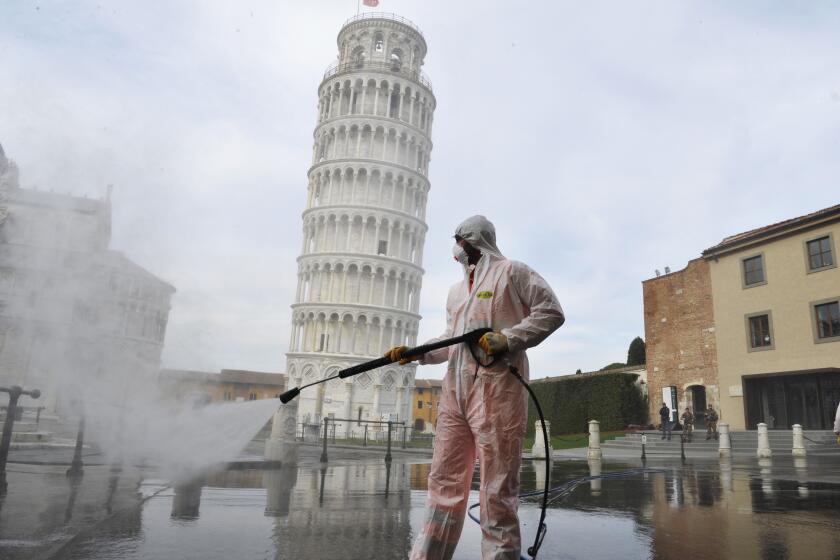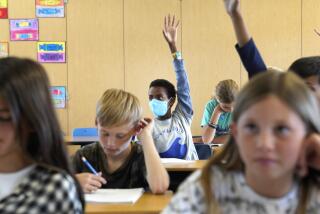Silicon Valley could face 2,000 to 16,000 coronavirus-related deaths, new estimates show
MILLBRAE, Calif. — Silicon Valley could see a coronavirus-related death toll of 2,000 to 16,000 by the end of May, depending on how seriously people take the order to stay at home as much as possible, according to projections presented at a San Jose City Council meeting this week.
The thinking behind the rough estimates illustrates why health and elected officials across California have sounded the alarm about the exponential rise in coronavirus cases reported since the beginning of March. Officials from Los Angeles Mayor Eric Garcetti to San Francisco’s director of public health, Dr. Grant Colfax, have warned about a surge in gravely ill coronavirus patients needing hospitalization in the next week or two.
“Even in the best case scenario, we were looking at the order — in the next 12 weeks — of 2,000 potential deaths directly from COVID-19,” San Jose deputy city manager Kip Harkness said Tuesday of an estimate of the projected death toll for Santa Clara County, California’s sixth most populous county.
Harkness emphasized the projections he presented are rough and the county is working on a more detailed and robust estimate. “But given the urgency of the situation, we have decided to share [these] preliminary results with you and the public today, in order to derive the action that is needed to save lives,” Harkness said.
If nothing were being done, the death toll from the virus that can cause severe respiratory problems could hit 16,000 people for this county of nearly 2 million people, with just one-fifth the population of Los Angeles County.
But if there’s a mediocre compliance with the shelter-in-place order issued across the San Francisco Bay Area on March 16 that was followed by a similar statewide order issued three days later — where “we do something, but [it’s] not well complied with” — there could still be a far worse death toll than the best-case scenario, with nearly 8,000 dead in Santa Clara County.
“It’s the hardest slide to look at,” said Harkness, who focuses on emergency preparedness for California’s third most populous city.
Why coronavirus cases are still rising despite shelter-in-place order
Cases of coronavirus are still rising in Santa Clara County, despite the sweeping shelter-in-place order issued across the San Francisco Bay Area just a little more than a week ago, because the cases of infection being identified now represent infections that occurred one to two weeks ago, Dr. Sara Cody, the Santa Clara County public health officer, told the county Board of Supervisors at a meeting Tuesday.
“The cases that we’re identifying now still reflect the transmission and what was happening in our community one to two weeks ago, so there’s that lag,” Cody said.
It can take two to 14 days after someone is infected with the coronavirus before the symptoms of the disease known as COVID-19 appear.
But it can take even longer to become seriously ill. Here’s the median time it took from the first signs of illness to the following outcomes, according to a study of patients in Wuhan, China:
- From illness onset to shortness of breath: 7 days
- From illness onset to sepsis: 9 days
- From illness onset to acute respiratory distress: 12 days
- From illness onset to intensive care unit admission: 12 days
- From illness onset to death or hospital discharge: 21 days
The latest maps and charts on the spread of COVID-19 in California.
That kind of timeline has also been seen in California.
The symptoms can seem relatively mild during the first week, with the main symptom being a cough, and the patient is treated as an outpatient.
It’s only in the second week where patients rapidly deteriorate, and in a matter of hours, they’re unable to breathe on their own and suddenly need a breathing tube inserted into the throat so they can be hooked up to a mechanical ventilator that pushes oxygen into the lungs, according to an interview that Dr. Stephen Parodi, a Kaiser vice president and infectious diseases physician, gave to the Journal of the American Medical Assn.
Next few weeks are critical
Officials also say the number of coronavirus cases in Santa Clara County is far greater than currently documented. As of Wednesday night, Santa Clara County reported 459 coronavirus cases and 17 deaths. But Harkness, the San Jose official, said it’s likely there are actually 9,000 to 19,000 people in Santa Clara County with the coronavirus infection.
“The current number of ... positive tests vastly undercounts the number of actual cases,” Harkness said. “That means we have a false sense of security in terms of thinking, ‘Oh, everyone who’s tested are the only ones who are infected.’ No, there are a large number of us walking around who are infected.”
More than 3,000 cases of coronavirus infection have been confirmed in California and 67 people have died of COVID-19. Will the state be the next Italy?
So the next few weeks are critical. First, if virtually everyone sticks with the strict stay-at-home orders established by the county and Gov. Gavin Newsom, that “will significantly bend the curve” of what would otherwise be an exponential rise in cases.
But the region still needs to find more intensive care unit beds and ventilators, Harkness said. Without them, the death rate for critically ill patients doubles.
Can rising demand for intensive care unit beds be met?
In the worst case scenario, if there had been no order for people to stay home as much as possible to curb the outbreak, demand for intensive care unit beds during the outbreak’s peak would vastly outstrip supply by many times, according to a slide Harkness presented.
A so-so approach, where many people don’t comply with the stay-at-home order, could still leave the county with too few ICU beds.
But strict adherence to the stay-at-home orders, combined with increasing the number of intensive care unit beds, could bring Silicon Valley close to meeting the demand, Harkness said.
“The most important thing that everybody can do is compliance with the public health orders — shelter-in-place. This is this weird moment where the biggest thing you can do to help is this: Do nothing. Go home. Stay on your couch. Watch some Netflix,” Harkness said.
“I know it’s hard, especially for those of us who think action is the thing we need to do,” he added. “But in this particular epidemic, ‘being’ may be more important than ‘doing’ for most of us.”
County racing to secure more ventilators
Santa Clara County has made efforts to increase its healthcare capacity. A 248-bed federal medical station is being established at Santa Clara Convention Center to be used as a “medical respite unit” for coronavirus-infected patients who don’t need to be hospitalized but can’t return home to care for themselves.
The county has ordered 211 mechanical ventilators and the state has promised to provide 100 more, Santa Clara County executive officer Dr. Jeffrey V. Smith, who is also a physician and a lawyer, told the Board of Supervisors on Tuesday. The county, which operates several hospitals, is also trying to hire more than 100 nurses.
The drivers of Santa Clara County’s economy — tech companies, foreign travel and close human interaction — made it a ripe target for the coronavirus.
Smith said the county is tracking how many beds are available in the region’s hospitals related to COVID-19, particularly in the intensive care unit. As of Tuesday, there are empty ICU beds and available ventilators, “but we’re very, very, very concerned that once a couple of weeks have expired, we will be really challenged.”
Of the 375 Santa Clara County residents who were confirmed to have the coronavirus infection as of Monday night, the severity of illness among them is still quite high. Cody, the health officer, said at the supervisors’ meeting Tuesday that 125 were hospitalized at the time of diagnosis, including 13 who were in the intensive care unit.
San Francisco leaders said Wednesday that it was plausible the city could face a crisis similar to that of New York City’s and fall short 1,500 ventilators and 5,000 hospital beds. “It is not even a question as to whether we will need more,” San Francisco Mayor London Breed said.
Testing for coronavirus still a challenge
Lab testing for the coronavirus to confirm whether an ill patient has the virus that causes COVID-19 is still a challenge for Santa Clara County. “Despite the announcements from the federal government, testing is not as widespread as we would like it to be, and as it needs to be,” Cody said Tuesday.
The local public health laboratory has been able to test for the virus since Feb. 26, but, like other state and local public health labs, was never designed to work like commercial labs. So they don’t offer high-volume testing capacity to process thousands of tests daily, Cody said, “which is why we are dependent on the commercial and academic sectors.”
Cody and other health officers in the San Francisco Bay Area on Tuesday issued a new order requiring labs to report to officials not only the positive coronavirus cases but the negative ones as well. The counties didn’t have a clear idea of how much testing was occurring in the region since the negative results hadn’t been reported to the local authorities.
“It will also enable us to understand if there are areas where there are higher positivity rates where there might be more intense transmission [of the virus] and that, of course, is very important for us to understand as we try to reduce transmission and bend the curve,” Cody said.
Epicenter of California’s coronavirus crisis
Santa Clara County has become the epicenter of California’s coronavirus crisis, with more deaths than any other county in the state.
Initial hints of problems surfaced when it became clear that, among sick people getting tested in Santa Clara County, the percentage of people testing positive to the new coronavirus was significantly higher than in other communities, Smith said. That was an ominous sign that suggested there was also a high percentage of people infected with the coronavirus who weren’t yet showing signs of illness.
About 80% of infected people show mild or minimal symptoms of illness.
Smith said an earlier projection mentioned by Newsom that more than half of Californians could be infected with the coronavirus in a two-month period was based on unfettered spread of the virus and is unlikely to occur.
“However, since Santa Clara has been at the forefront, we certainly need to be prepared, and our focus has been on trying to make sure our system is not overwhelmed,” Smith said Tuesday.
More to Read
Sign up for Essential California
The most important California stories and recommendations in your inbox every morning.
You may occasionally receive promotional content from the Los Angeles Times.














